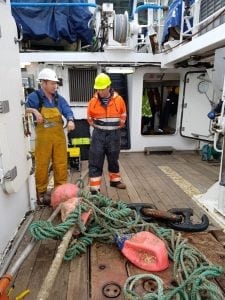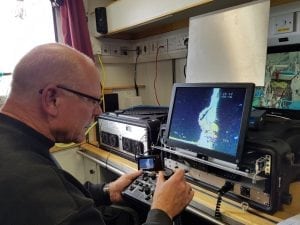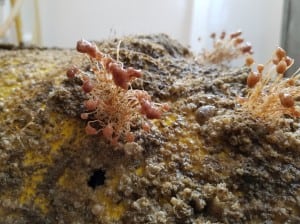Marine
The East Coast Marine Mammal Acoustic Study continues
August 4, 2016 by Marine Scotland Communications No Comments | Category Marine Directorate Science, Marine Directorate Surveys
The east coast of Scotland is home to several species of marine mammals and the animals are regularly monitored to make sure that the populations are healthy and also to improve our understanding of how and when they use different areas along the Scottish coast. The plans for marine developments along the east coast of Scotland, including the installation of wind farms and significant port re-construction, make it all the more important to continue studies of these populations. Collecting data, especially over time, will give us deeper understanding of how species like bottlenose dolphins and porpoise use the east coast waters, and allow us to determine whether developments have an impact on their behaviour so over a number of months, scientists in Marine Scotland have been involved in the East Coast Marine Mammal Acoustic Study (ECOMMAS) programme.
 More recently and following deployment of acoustic loggers at the end of April/early May, the ECOMMAS team were back at sea in July and early August to recover the cetacean detectors and sound recorders, and to redeploy another 30 units. This is high summer in the North Sea – but as anyone from the north east of Scotland knows, this doesn’t necessarily mean calm sunshine-filled days. Nevertheless, the cruise was conducted in generally good conditions, with no delays for foul weather and even some sunshine. This trip was far more successful than our last retrieval voyage in November 2015, when nine of the 30 moorings were missing. This time we managed to recover 27 out of 30, and replacement CPOD dolphin/porpoise click detectors and SM2M sound recorders were redeployed in the same locations.
More recently and following deployment of acoustic loggers at the end of April/early May, the ECOMMAS team were back at sea in July and early August to recover the cetacean detectors and sound recorders, and to redeploy another 30 units. This is high summer in the North Sea – but as anyone from the north east of Scotland knows, this doesn’t necessarily mean calm sunshine-filled days. Nevertheless, the cruise was conducted in generally good conditions, with no delays for foul weather and even some sunshine. This trip was far more successful than our last retrieval voyage in November 2015, when nine of the 30 moorings were missing. This time we managed to recover 27 out of 30, and replacement CPOD dolphin/porpoise click detectors and SM2M sound recorders were redeployed in the same locations.
Most of our equipment is moored using acoustic releases, or pop-ups. These allow us to leave the devices at the seabed for several months, but to release the equipment to float to the surface when they are triggered by a specific high-frequency sound signal, broadcast from the ship. At a few sites our gear is surface marked with a line from the equipment at the seabed to a dhan buoy (a floating flag pole) on the surface. At two sites off Cruden Bay we could see from the ship’s echosounder that there appeared to be equipment on the seabed at the location where we left it, but at one site the acoustic release was not responding, and at the other the dhan buoy was missing. So we decided that the fine weather was a good opportunity to use a small remote-controlled submarine (Remotely Operated Vehicle; ROV) to firstly see what was left at on the seabed, and secondly try and recover the mooring, including the valuable data.
Bill Ruck and Stu Salt from Moray First Marine joined us on board for two days, and brought with them Bill’s Outland 2000 ROV. Bill is a ROV expert, having worked in the oil industry for many years, and now runs his own company based here in north east Scotland. On the first ‘flight’, Bill quickly located our failed acoustic release at Cruden Bay 10 with CPOD still attached, and managed to attach a rope so we could bring the mooring to the surface. We found that the reason the acoustic release didn’t pop up was a failed battery – but more importantly we have recovered the data logger complete with several months data.
 At the Cruden Bay 15 location, where the mooring had been surface marked, a large and confused-looking echosounder target guided the ROV to a tangled mess on the seabed comprised of dhan pole and a mass of rope. Bill battled strong tidal currents to attach a line to a bight of rope, and we pulled the equipment to the surface, quickly discovering that not only was our April 2016 deployed mooring present, but also one that had been lost the previous autumn. The floating dhan buoys had somehow become tangled around themselves and sank. We salvaged the CPODs, both of which were encrusted with large numbers of sea anemones, barnacles and sea squirts. The ship’s crew, led by skipper Andy and mate Stanley, were exceptionally helpful in bringing the mess of equipment on board, and of course we could not have done this without Bill’s expert ROV piloting. Working with Bill and Stu we were able to recover three lost CPODs and additional ancillary equipment, which made for a productive and exciting end to the trip.
At the Cruden Bay 15 location, where the mooring had been surface marked, a large and confused-looking echosounder target guided the ROV to a tangled mess on the seabed comprised of dhan pole and a mass of rope. Bill battled strong tidal currents to attach a line to a bight of rope, and we pulled the equipment to the surface, quickly discovering that not only was our April 2016 deployed mooring present, but also one that had been lost the previous autumn. The floating dhan buoys had somehow become tangled around themselves and sank. We salvaged the CPODs, both of which were encrusted with large numbers of sea anemones, barnacles and sea squirts. The ship’s crew, led by skipper Andy and mate Stanley, were exceptionally helpful in bringing the mess of equipment on board, and of course we could not have done this without Bill’s expert ROV piloting. Working with Bill and Stu we were able to recover three lost CPODs and additional ancillary equipment, which made for a productive and exciting end to the trip.
Ewan Edwards, Marine Scotland Science
Further Information
- Previous East Coast Marine Mammal Acoustic Study (ECOMMAS) blog post
- Marine Scotland research vessel surveys



Leave a comment